| Srl | Item |
| 1 |
ID:
100733
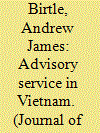

|
|
|
|
|
| Publication |
2010.
|
| Summary/Abstract |
uring the Vietnam War several beliefs gained currency that had negative implications for the men who labored as advisers. One was that the U.S. Army did not select its best men for advisory duty. Another was that promotion boards disregarded statements by senior Army leaders that command and advisory performance would be given the same weight when determining officer promotions. This article attempts to shed light on the question by examining the extent to which former Vietnam advisers achieved general officer rank in the U.S. Army.
|
|
|
|
|
|
|
|
|
|
|
|
|
|
|
|
| 2 |
ID:
100961
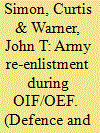

|
|
|
|
|
| Publication |
2010.
|
| Summary/Abstract |
In 2004, stretched by wartime deployments, the US Army countered declining retention by increasing re-enlistment bonuses and implementing stop-loss to prevent soldiers from separating at the end of their enlistment. We estimate the effects of bonuses, deployment, and stop-loss on re-enlistment between FY 2002 and 2006. We estimate that the baseline propensity to re-enlist fell by 20%. However, we find that deployed soldiers are more likely to re-enlist and that the estimated effects of re-enlistment bonuses are similar to those estimated in peacetime. We evaluate the reasons for our findings, and calculate the cost effectiveness of re-enlistment bonuses.
|
|
|
|
|
|
|
|
|
|
|
|
|
|
|
|
| 3 |
ID:
099697
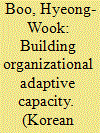

|
|
|
|
|
| Publication |
2010.
|
| Summary/Abstract |
This study delves into the issues of the U.S. Army's adaptive capacity in the Operation Iraqi Freedom (OIF) Phase IV. The author borrows the concept of organizational adaptive capacity while arguing that adaptive capacity framework can provide coherent theoretical explanations for the U.S. Army's unsatisfactory performance in OIF Phase IV. The author, then, tries to apply the analysis of U.S. Army's experience to the Republic of Korea (ROK) Army. The ROK Army has tried to follow the U.S. Army from doctrine to weapon systems and the author sees that there is a possibility that the ROK Army will be faced with similar challenges that the U.S. Army had to deal with. Thus, the author argues that drawing theoretical implications and lessons from U.S. experiences should be regarded important tasks for the ROK Army.
|
|
|
|
|
|
|
|
|
|
|
|
|
|
|
|
| 4 |
ID:
096159
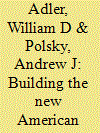

|
|
|
|
|
| Publication |
2010.
|
| Summary/Abstract |
Contend that contrary to traditional notions of a weak national state in our nation's early years, the national state, acting through the Army, was indispensable in shaping the pattern and direction of economic development. They propose a new way of conceptualizing the early American state: a state of the periphery, dominated by the Army, and a state of the center, in which other public institutions also performed key development functions.
|
|
|
|
|
|
|
|
|
|
|
|
|
|
|
|
| 5 |
ID:
104080
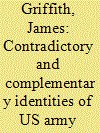

|
|
|
|
|
| Publication |
2011.
|
| Summary/Abstract |
Over the past three decades, evolving threats to U.S. national security have necessitated changes in the missions, structure, and organization of reserve forces. These changes, while intended to redefine the purposes and functions of the U.S. reserve force, at times had unanticipated effects on the individual reservist's experience of and identity with reserve military service. Emergent identities include the obliged-conscripted citizen soldier, weekend warrior, instrumental volunteer, identity seeker, soldier warrior, and conservative ideologue. The author elaborates on these identities and their association with geopolitical events and corresponding responses in the U.S. national defense strategy and concludes by discussing the implications of more recent identities for adequately staffing and readying the U.S. reserve force.
|
|
|
|
|
|
|
|
|
|
|
|
|
|
|
|
| 6 |
ID:
125367
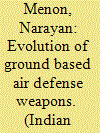

|
|
|
|
|
| Publication |
2013.
|
| Summary/Abstract |
In the not too distant past, the world's most powerful military of the US was poised to mount a short duration campaign to punish Syria for allegedly crossing some undefined 'red line' of employing chemical weapons against insurgent forces opposing the regime in power. Reports coming out of Washington indicated that the US President was not only determined to degrade Syria's chemical weapon capabilities but also to take down Bashar Assad's air force, destroy his air bases and knock out his ground-to-ground ballistic missiles using giant B-52 bombers and B-2 stealth bombers. Some of the bombers were planned to fly in directly from the US, others from a base in Qatar.
|
|
|
|
|
|
|
|
|
|
|
|
|
|
|
|
| 7 |
ID:
096789
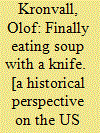

|
|
|
|
|
| Publication |
Oslo, Institute for Forsvarsstudier, 2007.
|
| Description |
53p.
|
| Series |
Oslo files on defence and security - 05/2007
|
| Standard Number |
15046753
|
|
|
|
|
|
|
|
|
|
|
|
Copies: C:1/I:0,R:0,Q:0
Circulation
| Accession# | Call# | Current Location | Status | Policy | Location |
| 055021 | 355.00973/KRO 055021 | Main | On Shelf | General | |
|
|
|
|
| 8 |
ID:
124233
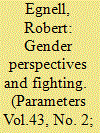

|
|
|
|
|
| Publication |
2013.
|
| Summary/Abstract |
Many concerns related to women in combat roles stem from two related assumption: (a) the existing structure and culture of the armed forces are well adapted to the requirements of combat; and (b) politically imposed change is harmful to the professionalism and effectiveness of the military. These can be dangerous assumptions. Instead, the traditional "truths" about the nature of unit cohesion and the optimal capabilities of individual soldiers and officers need to be periodically examined. Doing so can maximize the effectiveness of military organizations in a changing environment.
|
|
|
|
|
|
|
|
|
|
|
|
|
|
|
|
| 9 |
ID:
125189
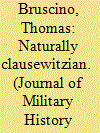

|
|
|
|
|
| Publication |
2013.
|
| Summary/Abstract |
American military theorists between the Civil War and World War II have garnered limited attention in military history, but they developed many ideas about the nature and practice of war. These theorists did not fixate on the writings of Carl von Clausewitz, but they were familiar with his work. But independent of Clausewitz, American military theory emphasized the Clausewitzian concept of the relationships among politics and society in preparing for and fighting wars. This article explores Clausewitz and American military theory, explains how Americans became naturally Clausewitzian, and discusses what their thinking has to do with the conduct of war.
|
|
|
|
|
|
|
|
|
|
|
|
|
|
|
|
| 10 |
ID:
102262
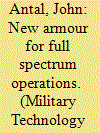

|
|
|
| 11 |
ID:
093106
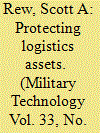

|
|
|
| 12 |
ID:
093102
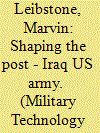

|
|
|
| 13 |
ID:
093103
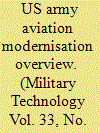

|
|
|
| 14 |
ID:
124232
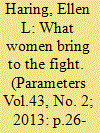

|
|
|
|
|
| Publication |
2013.
|
| Summary/Abstract |
The recent decision to integrate the US military fully was met with a range of emotions. For some it was a misguided decision that would erode combat effectiveness and have negative consequences for US security. Various objections were raised to justify keeping women out of combat units but most have been demolished by ten years of combat. This article exposes the flaws in two of the more persistent objections: (1) the presence of women in combat units will erode the vital bond that develops between men and (2) women are not as strong as men and so put male soldiers at risk.
|
|
|
|
|
|
|
|
|
|
|
|
|
|
|
|